Guiding Sebum Metabolomics: Significance, Challenges, and Methodological Insights
What is Sebum Metabolomics and Its Significance
The skin, as the body’s largest organ, functions not only as a protective barrier but also plays a crucial role in numerous physiological processes. Sebum, an oily substance secreted by sebaceous glands, enriches the skin surface with various lipids—triglycerides, free fatty acids, squalene, and wax esters—that help maintain skin lubrication and flexibility. Sebum metabolomics is the study of the diverse array of small molecules (metabolites) found within sebum. This field focuses on identifying and analyzing lipid-based and other low-molecular-weight compounds essential for skin health. Research in sebum metabolomics provides valuable insights into skin health, disease mechanisms, and the effects of environmental factors. Studying sebum metabolomics is significant for several key reasons:
- Skin Health Assessment: Sebum contains a wide array of metabolites that reflect the metabolic state of the skin. Analyzing these metabolites can provide information about skin conditions such as acne, eczema, and psoriasis, allowing for better diagnostics and personalized treatment options.
- Disease Mechanisms: Understanding the metabolomic profile of sebum can reveal underlying biochemical pathways involved in skin disorders. For example, alterations in fatty acid composition can indicate inflammatory processes or microbial dysbiosis, helping researchers identify potential therapeutic targets.
- Environmental Interaction: The skin interacts constantly with the external environment, including UV radiation, pollutants, and skincare products. Studying the metabolomics of the skin surface can provide insights into how these factors affect skin health and aging.
- Biomarker Discovery: Specific metabolites in sebum could serve as biomarkers for various skin diseases, enhancing early diagnosis and monitoring treatment efficacy. This can lead to the development of non-invasive diagnostic tools.
Challenges of Conducting Sebum Metabolomics
While the potential benefits of skin surface metabolomics are significant, several challenges can complicate research in this area:
- Sample Collection: Collecting sebum samples non-invasively poses practical difficulties. Techniques such as Sebutape patches or adhesive film can be used, but variability in sebum production between individuals can affect reproducibility and comparability of results.
- Complex Matrix: Sebum is a complex mixture of lipids, fatty acids, hydrocarbons, and other metabolites. The diversity of components necessitates advanced analytical techniques, such as mass spectrometry or nuclear magnetic resonance (NMR), which can be challenging to optimize for detecting specific metabolites.
- Metabolite Stability: The stability of certain metabolites in sebum can be affected by factors like temperature, light, and storage conditions. Proper handling and processing of samples are critical to prevent degradation and ensure accurate analysis.
Researchers are in urgent need of a comprehensive guide or standardized operating procedure (SOP) for studying sebum metabolomics. Such a guide would provide crucial insights into the optimal approaches for sampling, including recommendations on the most effective tape types and materials for sebum collection, as well as best practices for sample collecting steps, and the most suitable sample tapes numbers for optimal metablomics detection results. Additionally, it would address the most efficient extraction techniques for isolating a wide range of metabolites within sebum, ensuring high-quality data for downstream analysis. Establishing these standardized methods would greatly enhance reproducibility and reliability across sebum metabolomics studies, paving the way for more consistent and meaningful research findings in skin health and disease.
Optimizing Skin Surface Metabolomics: Methods and Insights
Recently, MetwareBio, as a co-author, published a research paper titled “Optimizing Skin Surface Metabolomics: A Comprehensive Evaluation of Sampling Methods, Extraction Solvents, and Analytical Techniques (article resource)” online in the esteemed dermatology journal, the Journal of Investigative Dermatology (JID). This study evaluated multiple key factors related to the processing of skin surface metabolomics samples, including sampling materials, extraction solvents, tape adhesion methods (such as the number of applications and the quantity of tape used), and analytical techniques, providing clear directions for addressing issues in sebum metabolomics research.
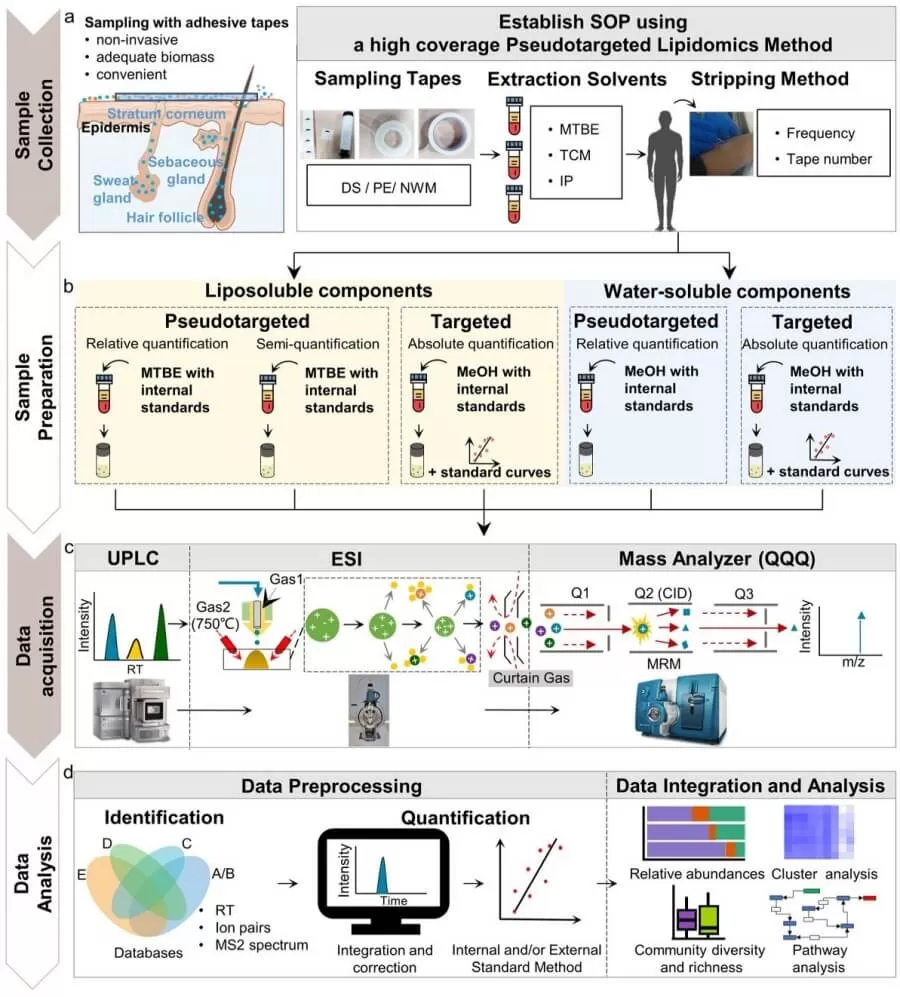
Impact of Tape Types on Lipid Detection on Skin Surface
The study focused on the volar aspect of the arm (characterized by a uniform pore distribution and low biological mass) and assessed the impact of three different types of adhesive tapes on skin metabolite sampling: D-Squame® D100 (DS), medical-grade polyethylene (PE), and medical-grade non-woven (NWM) tape. The samples were extracted using methyl tert-butyl ether and methanol (MTBE: MeOH 3:1, v/v). The results indicated that all three types of tape successfully detected compounds, albeit with different lipid preferences. Notably, the DS tape collected the highest quantity of lipids, demonstrating the best performance, while the PE and NWM tapes showed slightly lower efficacy.
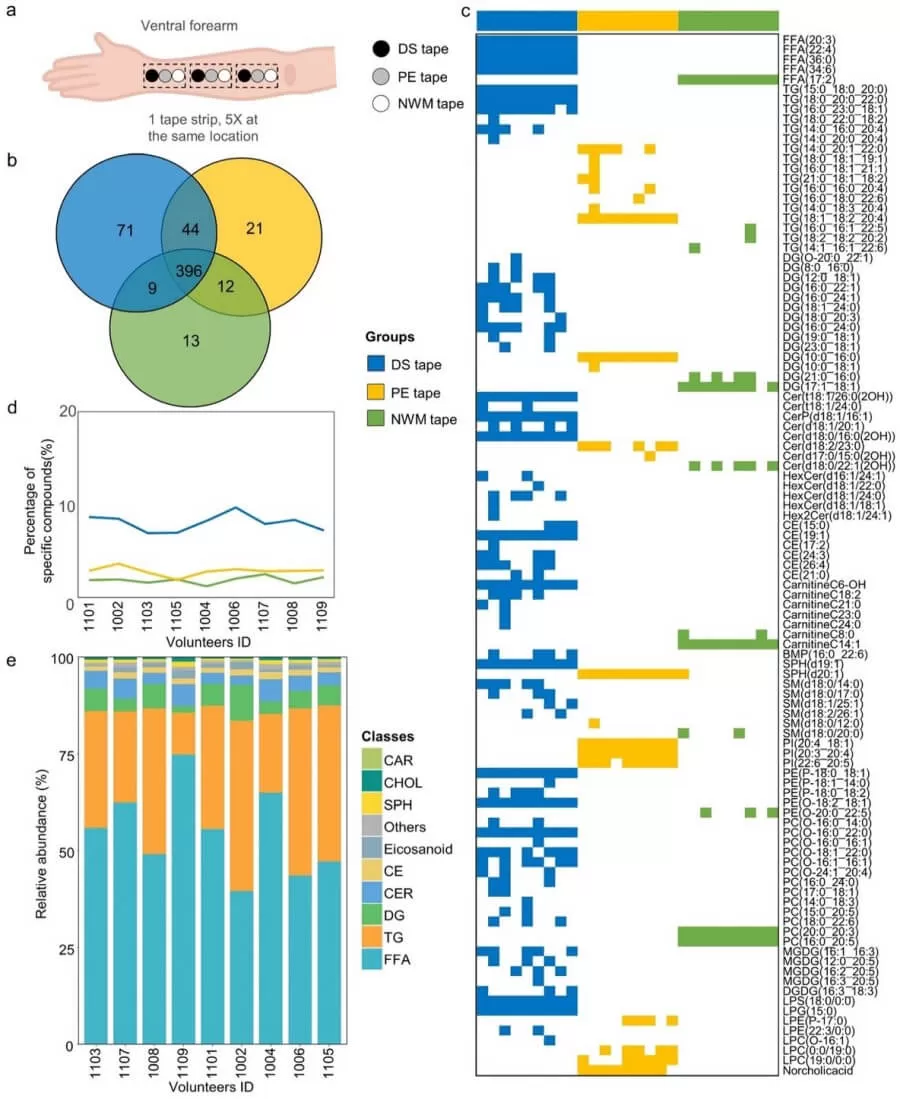
Influence of Extraction Solvents on Lipid Detection on Skin Surface
In the study, three extraction solvents were selected for sample extraction: methyl tert-butyl ether (MTBE), chloroform/methanol (TCM), and isopropanol (IP). Due to the phase separation properties and polarity differences of the extraction solvents, the complexity of subsequent processing and the ability to extract lipophilic compounds varied. The results showed that the DS tape and PE tape performed best when combined with MTBE, yielding the highest total number of detected substances. Notably, the combination of the DS tape with MTBE achieved the highest detection count. In contrast, the NWM tape detected the most compounds when using the IP extraction solvent, but the overall detection count was significantly lower than the other combinations. In summary, the combination of DS tape and MTBE extraction solvent was identified as the optimal preprocessing method for lipid identification on the skin surface.
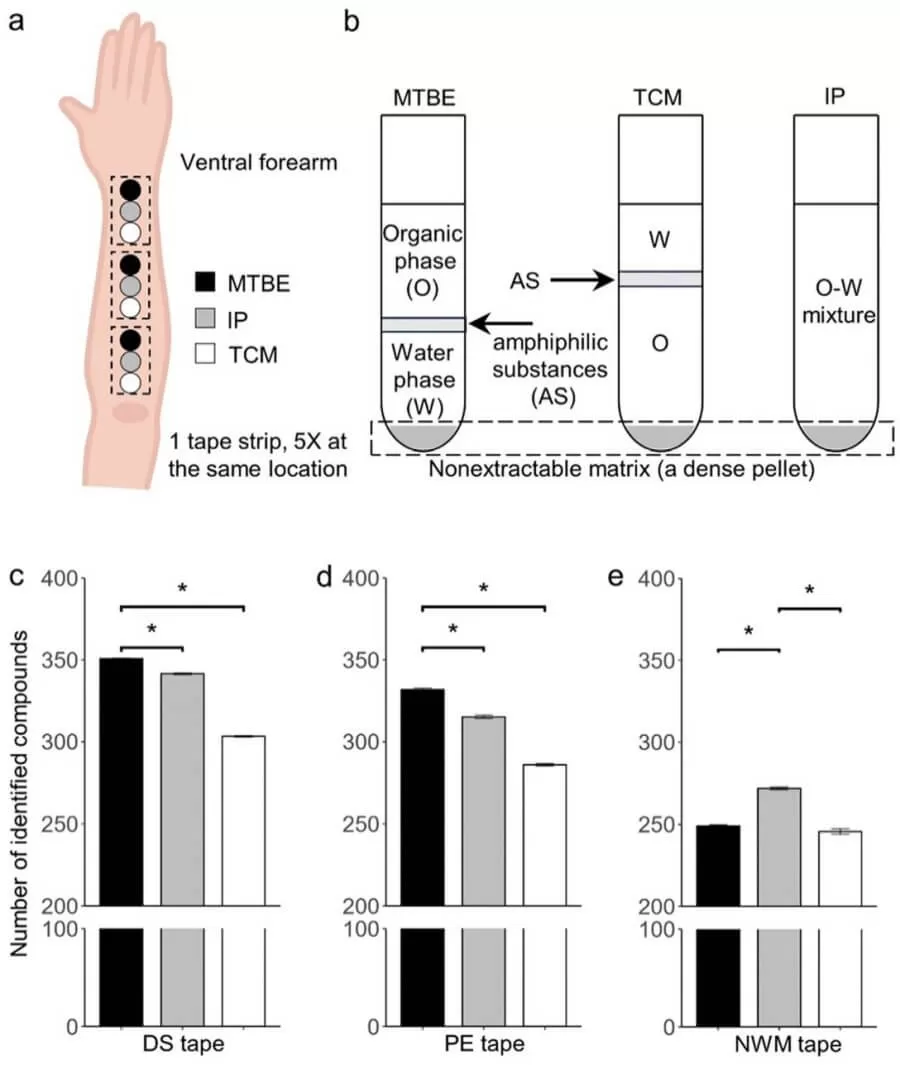
Effects of Tape Application Strategies on Metabolite Detection on Skin Surface
To establish standardized operating procedures (SOPs) for tape stripping in skin surface metabolomics research, the study further evaluated the tape stripping method, focusing specifically on the effects of the number of applications and the quantity of tape used. By comparing application counts of 3, 5, 8, and 10, the results revealed that the total number of identified compounds remained approximately 500 and did not significantly change with an increased number of applications. Notably, after the fifth stripping, the adhesive strength of the tape markedly declined, leading to the standardization of five applications for each tape type.
Additionally, the study examined the impact of tape quantity on metabolite detection by comparing results from one, two, and three strips. It was found that increasing the number of tape strips did not significantly affect the detection of lipophilic compounds; a single tape applied five times was sufficient to consistently identify around 500 compounds. However, for hydrophilic compounds, increasing the number of tape strips significantly enhanced detection counts, with some compounds only detectable when using two or more strips. Moreover, the increase in tape quantity improved the relative abundance of both lipophilic and hydrophilic compounds detected.
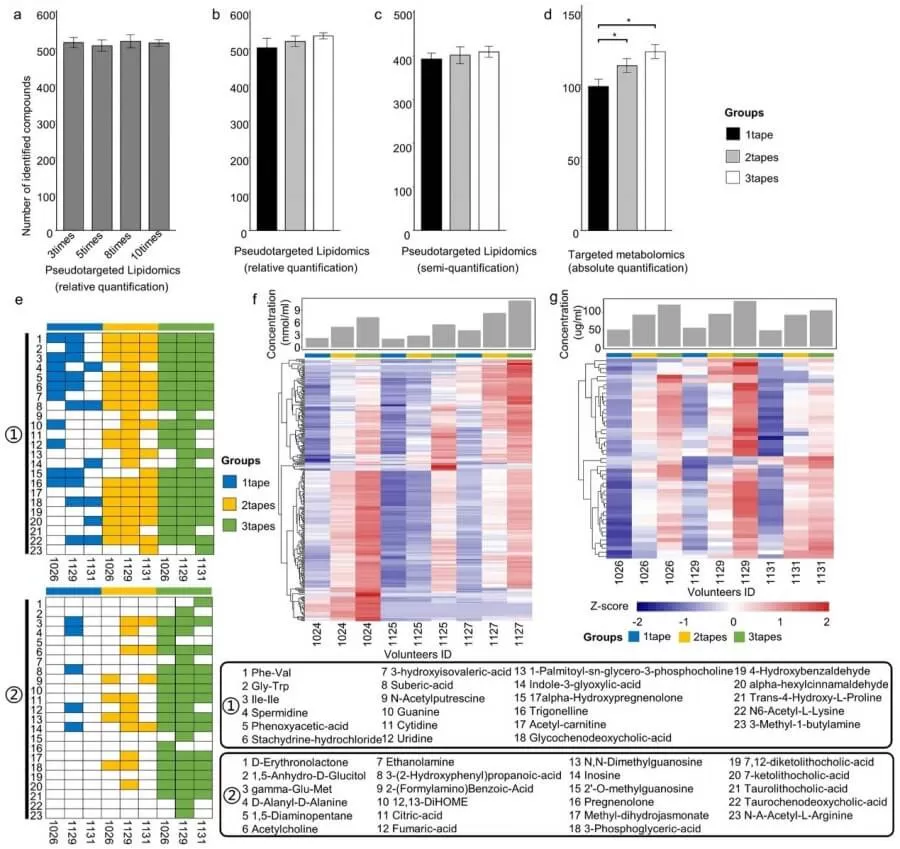
Characterization of Water-Soluble Metabolites in Healthy Skin
To gain a more comprehensive understanding of the water-soluble substances on the skin surface, the study employed both broad-targeted metabolomics and targeted metabolomics approaches. The broad-targeted metabolomics analysis identified a total of 695 compounds across 17 subclasses, while the targeted metabolomics identified 150 compounds spanning 25 categories. The core categories included organic acids, amino acids and their derivatives, and methylated amino acids, which together accounted for over 90% of the total water-soluble compounds. The six most abundant compounds were uric acid, acetamide, L-carnosine, histidine, urea, and serine, collectively constituting 85% of the total water-soluble compounds.
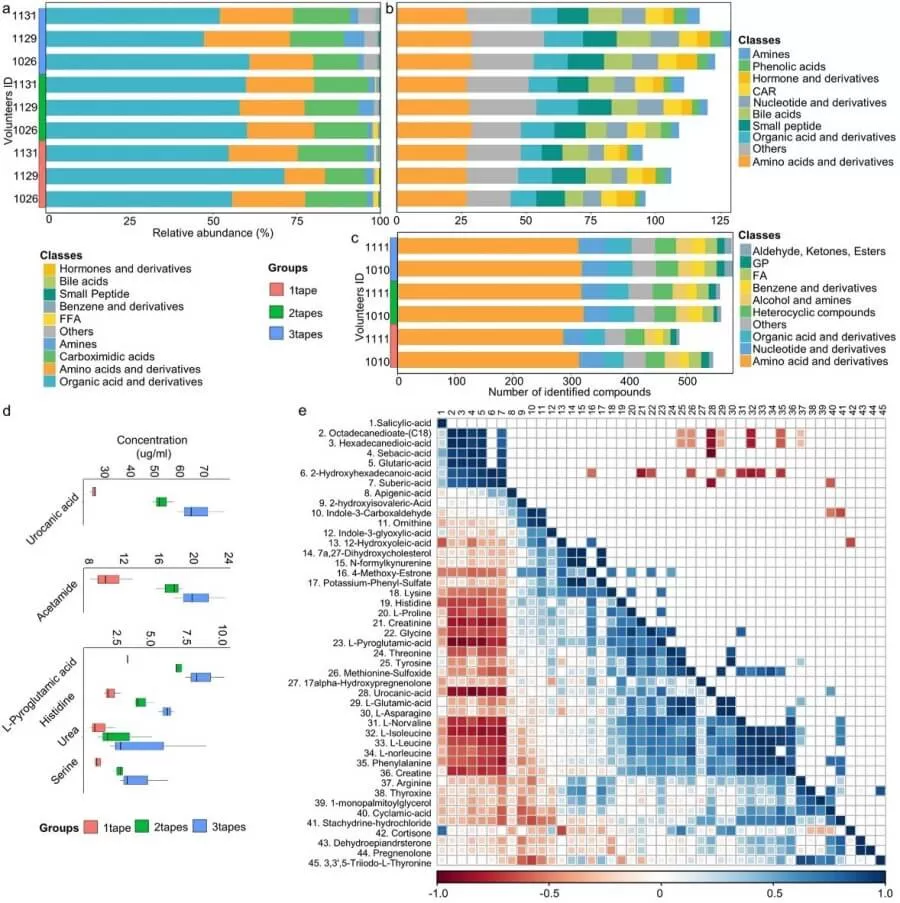
In conclusion, this study has established a comprehensive and reliable standard operating procedure (SOP) for skin surface metabolomics research. This foundational work is anticipated to significantly contribute to our understanding of skin biology and microbiome-host interactions, while also facilitating clinical explorations of disease biomarkers present on the skin surface.
Advancing Skin Surface Metabolomics Research with MetwareBio
Researchers studying skin surface metabolomics and lipidomics are encouraged to leverage this SOP as a guiding framework for their investigations. At MetwareBio, we are committed to advancing metabolomic research through cutting-edge technologies and methodologies. Our platform provides robust support for researchers looking to deepen their understanding of skin health and disease. By utilizing our expertise, you can enhance the reliability and reproducibility of your studies, ultimately leading to more meaningful and impactful findings in this exciting field. Join us at MetwareBio to elevate your research and contribute to the growing body of knowledge in skin surface metabolomics!


